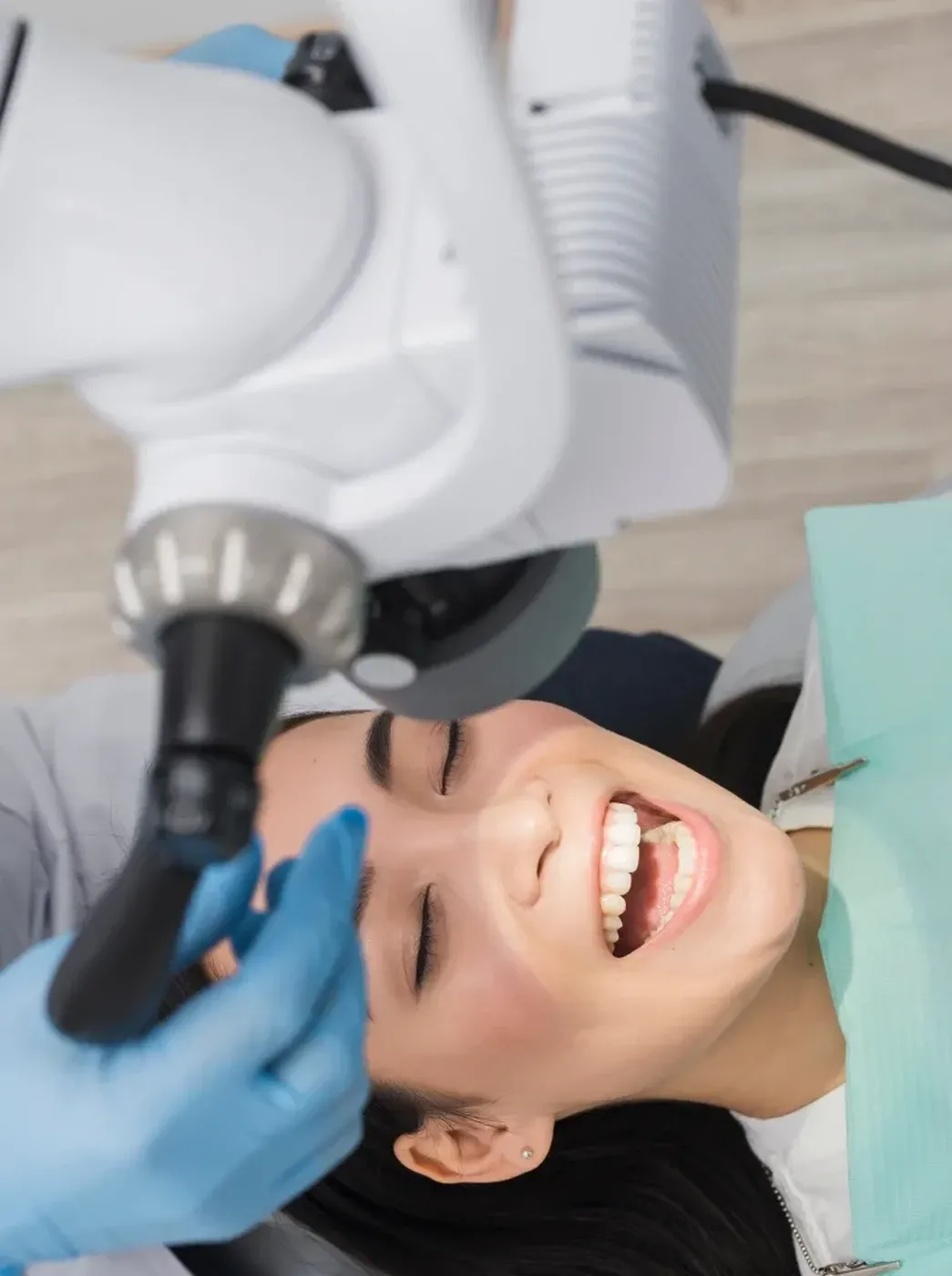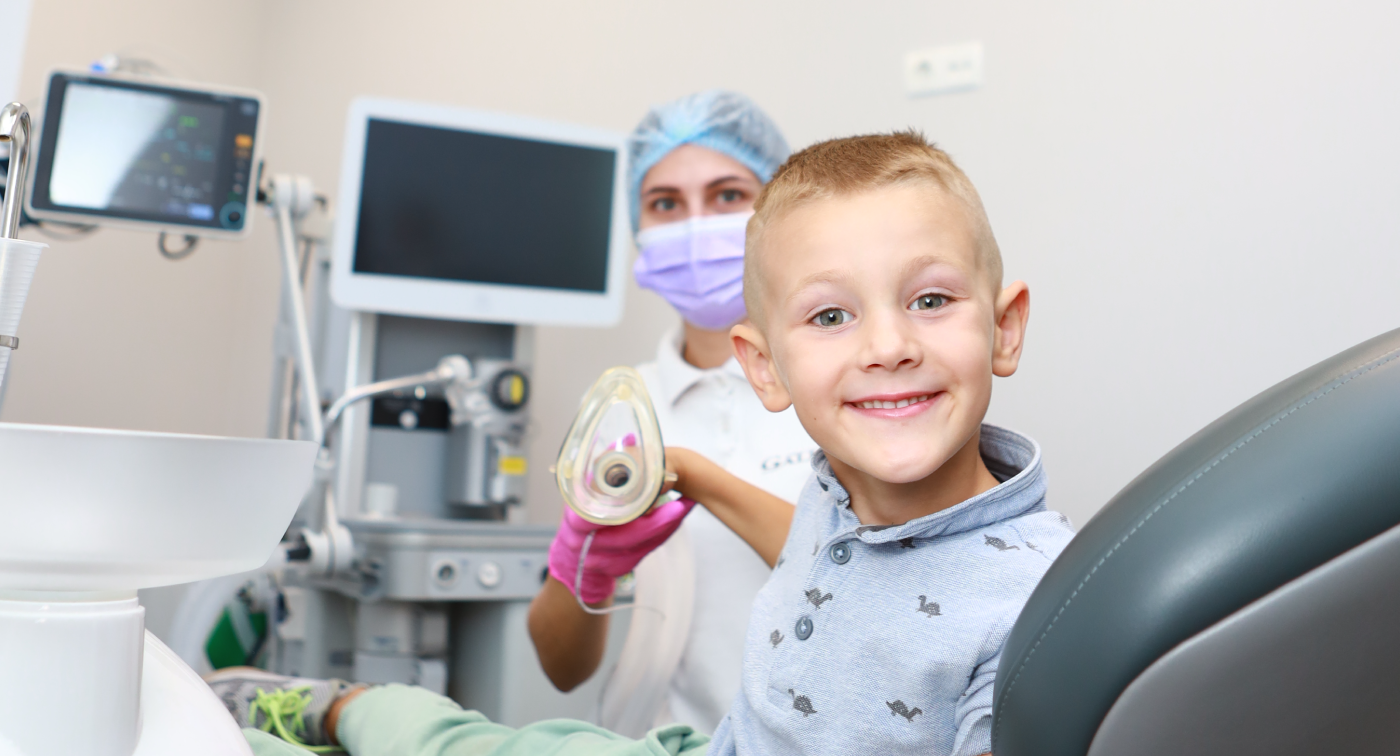
Treatment of children under medication-induced sleep (conscious sedation)
Treatment of children under medication-induced sleep – this is a comfortable way to go through all necessary procedures without stress and discomfort. This method suits both adults and children, allowing a significant amount of work to be done in one visit to the doctor. The patient falls asleep in the chair and wakes up after the treatment is finished, without feeling pain or anxiety. At Gallant Clinic, medication-induced sleep is used for children as a safe alternative to general anaesthesia. The procedure is done using light sedative drugs, which bring the patient into a calm, superficial sleep without affecting the cardiovascular and respiratory systems.
During treatment, a team of experienced specialists works near the patient: a dentist, a nurse, and an anaesthesiologist. The anaesthesiologist individually selects the drug dosage, monitors the patient’s condition during the procedure, and ensures a comfortable awakening.
Indications for sedation in paediatric dentistry
Treatment of baby teeth with medication-induced sleep is recommended in such cases:
- Need for complex dental intervention, including treatment or extraction of several teeth, when the child cannot sit still for long.
- Painful procedures, especially those involving gum incision.
- Allergic reaction to local anaesthetics.
- Fear of dental treatment.
- Strong gag reflex, which complicates manipulations.
- Presence of medical conditions that prevent the child from staying in the chair for a long time.
As for contraindications, among the relative limitations are active diseases of the cardiovascular and respiratory systems, anaemia, epilepsy. The final decision on the possibility of sedation is made by the anaesthesiologist after medical history is collected and after consultation with a paediatrician.
The duration of the procedure depends on the amount of necessary work. For example, extraction of a tooth in a child may take 15–20 minutes, and in an adult – up to 30 minutes. Tooth decay treatment takes up to an hour, and pulpitis – up to 1.5 hours. Procedures like implantation may last longer.
Features of sedation and types of the procedure
One common mistake among patients is equating anaesthesia with sedation. In reality, these are different pain control methods.
Under general anaesthesia, drugs completely “switch off” consciousness, blocking the central nervous system. As a result, artificial support of breathing and heart function is needed.
Sedation works more gently. It causes muscle relaxation and puts the patient into a state of light sleep without suppressing vital functions. In mild sedation, a person may remain conscious and respond to the doctor’s requests. Sensitivity is partially preserved, so the procedure is often supplemented with local anaesthesia.
In dentistry, general anaesthesia is rarely used. An alternative is sedation – it ensures patient comfort but is easier for the body to tolerate. With the correct drug and dosage, this method causes no complications. Awakening happens immediately after the procedure, and within 15–20 minutes the patient feels normal.
Types of sedation:
- Intravenous – the drug is injected through a catheter into a vein.
- Inhalation – an aerosol is used, inhaled through a mask.
- Combined – combines both methods for enhanced effect.
The optimal sedation option is chosen by the doctor, considering the patient's condition, the amount and duration of the treatment.
At Gallant Clinic, modern drugs with proven effectiveness and safety are used. As a result, the patient enters medication-induced sleep. The drugs allow for depth control and let the patient quickly return to normal after the procedure.
How to prepare children for dental treatment in sleep
Before the procedure, the dentist evaluates not only the condition of the oral cavity but also the general health status. It’s important to inform the doctor about chronic diseases, allergies, and other individual features. This helps choose a safe and effective sedative.
To exclude possible contraindications, the doctor may prescribe:
- general and biochemical blood tests;
- blood clotting test;
- tests for HIV, hepatitis B and C;
- electrocardiogram (ECG);
- consultation with a therapist or paediatrician.
The day before the procedure, it’s necessary to avoid food for at least 6 hours and water – for 2 hours. Infants can be fed no later than 4 hours before sedation.
If the patient has chronic diseases or is taking medications, it’s worth discussing this with the doctor in advance to receive personalised recommendations.
How does treatment in medication-induced sleep proceed?
Dental treatment in sleep requires careful patient preparation and takes place in several stages:
- Consultation with a dentist – the doctor determines the necessary procedures and selects the sedative drugs.
- Examinations – the patient provides blood tests, ECG, and, if needed, consults with the anaesthesiologist and other specialists.
- Treatment procedure – the patient is put into medication-induced sleep, and all necessary manipulations are carried out.
The therapy looks like this:
- The patient comes to the clinic at the scheduled time, sits in the dental chair, and receives the sedative – by injection via catheter into a vein or by aerosol through a mask. In children, inhalation sedation is usually used.
- Within 1–2 minutes, the patient falls asleep. Then a monitoring device is connected to track vital signs like breathing and heartbeat. The anaesthesiologist monitors these during the entire procedure and adjusts the drug dose if necessary.
- The dentist performs the necessary manipulations – from caries treatment and filling to tooth extraction or implantation.
- After the treatment, the anaesthesiologist wakes the patient from medication-induced sleep.
In paediatric dentistry, sedation is most often used, which does not significantly affect the central nervous system and does not disturb breathing or other vital functions. After the procedure, the anaesthesiologist stops the drug administration, and the child wakes up in a few minutes – usually within 5 to 10 minutes.
Request a call
We will contact you to schedule a convenient time for your consultation and connect you with the right specialist
What drugs are used in the medication-induced sleep?
At Gallant Dental Clinic, we use the safest medication available — Propofol. When the child falls asleep, the doctor begins treatment. During medication-induced sleep, a mask is also used to deliver sevoflurane (Sevoran or Sevoflurane, made in Italy) so that the child does not feel pain during the intravenous injection of Propofol.

How long does dental treatment for children under sedation take?
Treatment of children's teeth under medication-induced sleep (sedation) depends on the amount of work and the number of teeth that require treatment. Therefore, it is very important to make an appointment for a consultation at Gallant Dental Clinic so that the pediatric dentist can determine, during the child's examination, how long the child will need to be under sedation.

What are the benefits of treating children under medication-induced sleep?
- Painlessness
- Absence of stress
- Treatment effectiveness
- Possibility of performing comprehensive treatment

When medication-induced sleep is used?
- Long dental procedures: Treatment of multiple teeth, tooth extractions, or other complex interventions.
- Severe fear of dental treatment: If a child is very afraid of the dentist, sedation helps to relieve this stress.
- Low pain threshold: For children who have a strong reaction to pain.
- Special needs: Children with neurological or mental disorders who cannot calmly tolerate procedures.

Testimonials
I want to share our story with you. We turned to Gallant for the removal of all four wisdom teeth. The question was how to do it with the least stress for our child. After weighing all the pros and cons and consulting with more than one doctor, we decided to go with removal “under sedation.”And the day finally came... We arrived about 10 minutes early, filled out the necessary documents, and the nervousness was taking over. The anesthesiologist, postponing the scheduled removal, was providing first aid to me (kind of a support for my daughter). The procedure went quickly, efficiently, and with minimal stress for the child. The team of young specialists was competent, polite, and positive. The anesthesiologist called afterwards and showed concern for both my condition and my daughter’s. Three days later, the drains were removed, and a week after that, the stitches were taken out. There was no swelling or bruising at all. If you are still hesitating whether to endure it awake or choose sedation, make the right choice — treatment “in sleep.”
Thank you to the staff of this dental clinic for treating my daughter’s teeth under sedation! Everything went very well — they constantly monitored her condition and explained everything with great responsibility! Right after the procedure, they began waking my daughter up; she was relaxed, so they moved her to a room where she fully recovered. Later at home, she felt very good and was amazed that her teeth were treated painlessly. She happily said that if her teeth hurt again, she would want the treatment done under sleep! I highly recommend this type of treatment under sedation because it’s unlikely your child will be able to sit through the entire procedure!


Request a call
We will contact you to schedule a convenient time for your consultation and connect you with the right specialist

Request a call
We’ll get back to you shortly!

Leave a Review
Your feedback means a lot to us!


